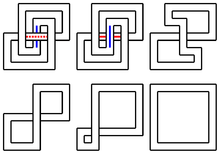Unknotting number

Trefoil knot without 3-fold symmetry being unknotted by one crossing switch.
In the mathematical area of knot theory, the unknotting number of a knot is the minimum number of times the knot must be passed through itself (crossing switch) to untie it. If a knot has unknotting number , then there exists a diagram of the knot which can be changed to unknot by switching crossings.[1] The unknotting number of a knot is always less than half of its crossing number.[2]
Any composite knot has unknotting number at least two, and therefore every knot with unknotting number one is a prime knot. The following table show the unknotting numbers for the first few knots:
 Trefoil knot
Trefoil knot
unknotting number 1 Figure-eight knot
Figure-eight knot
unknotting number 1 Cinquefoil knot
Cinquefoil knot
unknotting number 2 Three-twist knot
Three-twist knot
unknotting number 1 Stevedore knot
Stevedore knot
unknotting number 1 6₂ knot
6₂ knot
unknotting number 1 6₃ knot
6₃ knot
unknotting number 1 7₁ knot
7₁ knot
unknotting number 3
In general, it is relatively difficult to determine the unknotting number of a given knot. Known cases include:
- The unknotting number of a nontrivial twist knot is always equal to one.
- The unknotting number of a -torus knot is equal to .
- The unknotting numbers of prime knots with nine or fewer crossings have all been determined.[3] (The unknotting number of the 1011 prime knot is unknown.)
Other numerical knot invariants
See also
References
- ↑ Adams, Colin Conrad (2004). The knot book: an elementary introduction to the mathematical theory of knots. Providence, Rhode Island: American Mathematical Society. p. 56. ISBN 0-8218-3678-1.
- ↑ Taniyama, Kouki (2009), "Unknotting numbers of diagrams of a given nontrivial knot are unbounded", Journal of Knot Theory and its Ramifications, 18 (8): 1049–1063, doi:10.1142/S0218216509007361, MR 2554334.
- ↑ Weisstein, Eric W. "Unknotting Number". MathWorld.
External links
This article is issued from Wikipedia - version of the 4/15/2014. The text is available under the Creative Commons Attribution/Share Alike but additional terms may apply for the media files.